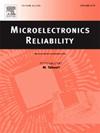Vibration characteristics and lead stress optimization for printed circuit board with PQFP under random loads
IF 1.9
4区 工程技术
Q3 ENGINEERING, ELECTRICAL & ELECTRONIC
引用次数: 0
Abstract
Random vibration loads are one of the important causes of electronic device failure, and it is necessary to conduct vibration reliability analysis on the circuit boards and their leads that are prone to failure. In this paper, a finite element model of the printed circuit board (PCB) with plastic quad flat package (PQFP) is established, to investigate the reliability design of the PCB under random vibration load. The modal analysis of the circuit board is conducted using the digital image correlation (DIC) technology combined with the force hammer method, which is a non-contact measurement method, to verify the validity of the simulation model and avoid the additional mass caused by contact measurement. Based on the verified model, the optimal parameter configuration of PCB thickness (H1), package thickness (H2), lead width (w), thickness (t), length (l) and foot angle (θ) is obtained by using Taguchi orthogonal method. After the collaborative optimization of the structural parameters of the PCBA, the maximum equivalent stress value of the leads decreased by 33.54 %. Based on the response surface method, a nonlinear mapping relationship between the lead stress and the component placement was established with the offset in the X and Y directions as variables. The response surface results show that the lead stress varies non-monotonically with the component offset, and there exists an optimal placement of the component with the minimum lead stress. Moreover, the maximum stress value of the component leads is highly sensitive to the combined effect of the X and Y offset. The optimal offset from the center position reduces the lead stress by 72 %. In addition, the circuit boards before and after optimization are compared under different random vibration environments, the results show that the lead stress of the optimized circuit board is 48 % smaller than that of the unoptimized circuit board, verifying the effectiveness of the optimization design. The simultaneous optimization provides a systematic framework for early-stage design optimization, reducing development costs and improving reliability.

随机载荷下PQFP印刷电路板振动特性及引线应力优化
随机振动载荷是导致电子设备故障的重要原因之一,有必要对易发生故障的电路板及其引线进行振动可靠性分析。本文建立了塑料四平面封装印刷电路板(PCB)的有限元模型,研究了随机振动载荷下PCB的可靠性设计。采用数字图像相关(DIC)技术结合力锤法(一种非接触测量方法)对电路板进行模态分析,验证仿真模型的有效性,避免接触测量带来的附加质量。在验证模型的基础上,利用田口正交法得到了PCB厚度(H1)、封装厚度(H2)、引线宽度(w)、厚度(t)、长度(l)和脚角(θ)的最优参数配置。协同优化PCBA结构参数后,引线的最大等效应力值降低了33.54%。基于响应面法,以X、Y方向偏移量为变量,建立了导线应力与构件位置的非线性映射关系。响应面结果表明,导线应力随元件偏移量呈非单调变化,且存在导线应力最小的元件最佳位置。此外,组件引线的最大应力值对X和Y偏移的综合影响非常敏感。从中心位置的最佳偏移量减少了72%的引线应力。此外,将优化前后的线路板在不同随机振动环境下进行对比,结果表明,优化后线路板的引线应力比未优化线路板的引线应力小48%,验证了优化设计的有效性。同时优化为早期设计优化提供了系统框架,降低了开发成本,提高了可靠性。
本文章由计算机程序翻译,如有差异,请以英文原文为准。
求助全文
约1分钟内获得全文
求助全文
来源期刊

Microelectronics Reliability
工程技术-工程:电子与电气
CiteScore
3.30
自引率
12.50%
发文量
342
审稿时长
68 days
期刊介绍:
Microelectronics Reliability, is dedicated to disseminating the latest research results and related information on the reliability of microelectronic devices, circuits and systems, from materials, process and manufacturing, to design, testing and operation. The coverage of the journal includes the following topics: measurement, understanding and analysis; evaluation and prediction; modelling and simulation; methodologies and mitigation. Papers which combine reliability with other important areas of microelectronics engineering, such as design, fabrication, integration, testing, and field operation will also be welcome, and practical papers reporting case studies in the field and specific application domains are particularly encouraged.
Most accepted papers will be published as Research Papers, describing significant advances and completed work. Papers reviewing important developing topics of general interest may be accepted for publication as Review Papers. Urgent communications of a more preliminary nature and short reports on completed practical work of current interest may be considered for publication as Research Notes. All contributions are subject to peer review by leading experts in the field.
 求助内容:
求助内容: 应助结果提醒方式:
应助结果提醒方式:


